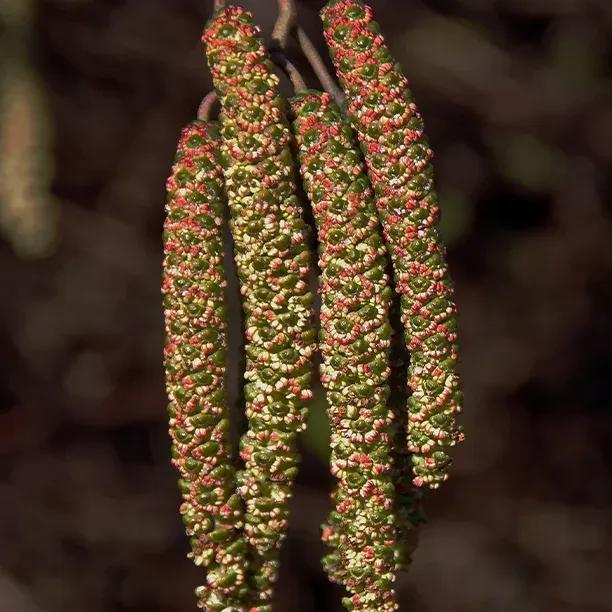Red Alder Sapling Trees
Honest Delivery PricesAlnus rubra
Sapling Trees- American tree.
- Grows v. fast. Loves wet sites.
- Adds nitrogen to soil, big catkins.
- Sizes: Saplings & Standards
- Rough hedging. Good tall screening.
- Max. Height: 20m
- Bareroot Delivery Only: Nov-Mar.
Description
Alnus rubra: Bareroot Red Alder Saplings
Delivered by Mail Order Direct from our Nursery with a Year Guarantee
Red or Oregon Alder, Alnus rubra, makes a neat screening tree with a fairly narrow, tapering canopy and slightly pendulous branches. Unlike other Alders, it does not make a lot of suckers around the base. They have ruddy-brown catkins in spring, before the crinkled leaves appear.
Young plants are very vigorous, and will reach 20 metres.
The plants on this page are young saplings, ideal for planting as rough country hedging, or in woodland projects.
You can also buy larger Red Alder trees, which will give you more of an instant impact as a garden specimen.
Browse our other Alder varieties or our full range of hedging and saplings.
Delivery season: Alder is delivered bareroot during late autumn and winter, approximately November-March inclusive.
Features:
- Height: 20m
- Soil: Any, ideal for poor & wet sites. Needs full sun.
- Grows on the coast
- Use: Screening, reclaiming, erosion prevention
- Adds nitrogen to soil. Big catkins.
- Colour: Yellow Autumn leaves
- Bareroot delivery only: November-March
Growing Red Alder
Red Alder will grow in very wet sites and poor soils, although it prefers sandier soils to heavy clay. It needs full sun.
Spacing a Red Alder hedge: Plant Red Alder hedging at 3 plants per metre, 33 apart.
Alders in general are not well suited to formal, tidy hedges because of their vigour, but because Red Alder doesn't sucker much either, it won't form as dense of a wildlife friendly thicket as other varieties, so we think that Italian Alder or Common Alder are better for that purpose.
Note: Alders have invasive roots that can break old water pipes and damage the foundations of old buildings or walls. 15 metres away from vulnerable structures is a safe distance. New build, concrete foundations are not at risk.
Planting Instructions
Growing Red Alder:
Red Alder needs a sunny site, ideally with moist or wet soil. They prefer lighter, sandier soils to heavy clay, and will grow on very poor, degraded soils. They will grow near the sea, and although they are hardy across Britain, they aren't ideal for exposed sites or frost pockets in the North-East, where they will probably suffer some damage from late spring frosts. Common Alder and Grey Alder are the hardiest of the group. If your soil is very dry, Italian Alder is a better choice.
Red Alder will not grow in the shade or on chalk.
Prepare your site before planting:
Red Alder is very tough. The only essential preparation is to kill the weeds in a strip a metre wide along the planting site: improving the soil should not be necessary. If your soil is exceptionally poor and dry, then digging in some well rotted manure and/or compost is worthwhile.
Watch our video on how to plant a country hedge for full details. The instruction to cut the plants in half after planting only applies to thorny native hedging and plants in the conservation hedge mix: this isn't necessary for Red Alder.
Remember to water establishing plants during dry weather for at least a year after planting. Watering should be thorough, so the ground is soaked. Let the soil almost dry out before watering again. You will also need to weed around the plants.
Hedge Planting Accessories:
Prepare your site for planting by killing the weeds and grass.
You can buy a hedge planting pack with sheets of mulch fabric and pegs to hold it down.
If you are planting in an area with rabbit and/or deer, you will need to use a plastic spiral guard for each plant, supported by a bamboo cane.
If your soil quality is poor, we recommend using mycorrhizal "friendly fungi" on the roots of new trees and shrubs.
You can also improve your soil with bonemeal organic fertiliser.
Trimming Country hedge plants: Hard prune after planting, then cut off 50% of the new growth next Winter. From the winter after that, trim lightly once every winter, until it is mature. When it is fully grown, you can clip it at anytime.
Special notes on caring for Red Alder hedges:
Tough and disease free, it shouldn't need special attention once it has established. If you didn't use a mulch fabric, it is beneficial to mulch around the base of the hedge each year.
Hygiene & Diseases:
Dead, damaged or diseased wood can be pruned off as soon as it appears.
Disinfect your pruning tools between every cut if there is any sign of disease.
Burn or dispose of any diseased material, do not compost it.
Did You Know?
It hails from the West coast of North America, where it is a classic pioneer tree that quickly colonises bare ground after storms, fires, logging or shifts in a river's banks after a flood.
Alders fix nitrogen into the soil, making it available over time for nearby plants to use. They are commonly used to reclaim sites with very poorly fertile soil, or to help prevent erosion.


